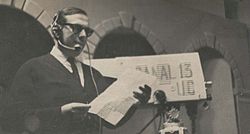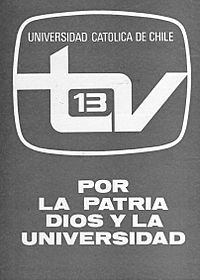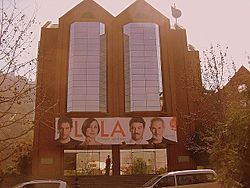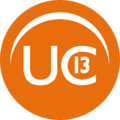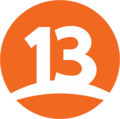Canal 13 (Chilean TV network) facts for kids
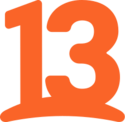 |
|
| Country | Chile |
|---|---|
| Broadcast area | Chile Latin America the Caribbean Spain |
| Headquarters | Santiago, Chile |
| Programming | |
| Language(s) | Spanish |
| Picture format | 1080i HDTV (downscaled to 16:9 480i for the SDTV feed) |
| Ownership | |
| Owner | Canal 13 SpA Grupo Luksic (through TV Medios Investments Ltd.) |
| Sister channels | T13 en vivo 13 Internacional 13C Rec TV |
| History | |
| Launched | August 21, 1959 |
| Former names | Canal 2 UC (1959–1961) Canal 13 UC (1961–1970) Corporación de Televisión de la Universidad Católica de Chile (1970–1982) Universidad Católica de Chile Televisión (1982–1999) Corporación de Televisión de la Pontificia Universidad Católica de Chile (secondary, 2000–2002) |
| Availability | |
| Terrestrial | |
| Digital VHF | Listings may vary |
Canal 13 is a television channel in Chile that you can watch for free. People in Chile often call it El 13 (The Thirteen). It is the second oldest TV station in the country. It started broadcasting on August 21, 1959, in Santiago. A group of engineers from the Pontifical Catholic University of Chile created it. The channel first used VHF channel 2, but later moved to VHF channel 13, which is how it got its current name. A big moment for Canal 13 was when it showed the 1962 FIFA World Cup, which was held in Chile.
The channel was originally called Corporación de Televisión de la Pontificia Universidad Católica de Chile. In 2010, the university sold most of its shares to a company called Grupo Luksic, owned by Andrónico Luksic Craig. By 2017, Grupo Luksic owned the entire channel.
Canal 13's main studios are in the Eleodoro Rodríguez Matte Television Centre. This huge complex in Providencia, Santiago Metropolitan Region, has been home to the channel's shows and broadcasts since the 1980s. It covers an area of 5 hectares (about 12 acres). Since 1998, the building has been named after Eleodoro Rodríguez Matte, a former director who worked there for a very long time.
Contents
History of Canal 13
Early Days and First Broadcasts (1952-1973)
On November 25, 1952, the Catholic University in Santiago, Chile, received its first TV equipment. Two teams were formed: a technical team and an artistic team. On December 12, they broadcast their first experimental program. It was a closed circuit broadcast, meaning it was only shown in one place, but it was a success. In January 1953, the university worked with a radio station for the first public TV broadcast in Chile.
In 1959, new equipment was bought, and test broadcasts began on July 17. On August 21, 1959, at 7:00 p.m., experimental broadcasts officially started. They used VHF channel 2 and showed three films a week. These broadcasts stopped on December 31 due to an accident. In January 1960, the Television Department was created to officially organize the station.
Official broadcasts began on Saturday, April 15, 1961, at 6:00 p.m., on channel 13. Before that, test broadcasts were done to get the equipment ready. A studio was built at the University's Central House. The channel's first program, Recuerdos de la Pérgola de las Flores, was broadcast from there. Other early shows like El Show de Antonio Prieto and Tricotilandia were the first entertainment programs on Chilean TV. They also introduced commercial advertising.
In 1962, Canal 13 successfully broadcast the 1962 FIFA World Cup from Chile. This was possible because they received new cameras and other equipment. Canal 13 showed important matches, including the final. After the World Cup, the channel paused broadcasts for about a month to make technical adjustments. It resumed on July 22 with more programs.
In August 1962, Show Dominical started. In 1965, it moved to Saturdays and became Sábados Alegres, then Sábados Gigantes. This show, hosted by Mario Kreutzberger, known as Don Francisco, became one of the longest-running and most successful variety shows in Latin America. On October 2, 1962, the channel's studios were officially opened.
In 1963, the first Press Department for Chilean TV was created. The Dramatic Department also started, producing shows like The Greenhouse. In 1964, Canal 13 began broadcasting seven days a week and covered the presidential elections. In 1965, the channel started using videotape to record programs, which was a big step forward.
In 1967, the comedy show Juani en Society was very popular. On August 9, 1968, Canal 13 received its first satellite transmission, a live broadcast from the Chilean Embassy in Washington D.C.. On July 20 and 21, 1969, it helped broadcast the live coverage of humans landing on the Moon, working with other channels.
On March 1, 1970, the news program Teletrece began. It is still on air today, making it the oldest news program in Chile. In 1972, Angelito de Canal 13, the channel's first mascot, was introduced. On December 24, 1972, the channel expanded its broadcasts to other cities. Canal 13's efforts to reach more of the country caused some debate because its news often disagreed with the government at the time.
On September 11, 1973, when the government of Salvador Allende was overthrown, Canal 13 was the only TV channel allowed to broadcast by the new military government. For three days, Canal 13 used the frequency network of another channel, TVN, because TVN and Channel 9 were off the air.
Growth and Expansion (1974-1999)
In 1974, Eleodoro Rodríguez Matte became the new director of Canal 13. The channel's programming increased, and it started broadcasting daily from 9:00 a.m. to 1:00 a.m. It also began retransmitting its programs to other cities.
In 1975, the government stopped giving money to university TV stations. So, Canal 13 started to rely only on advertising and money from the Catholic University. Soon, advertising money helped the channel grow and make a profit. This led to new popular shows like Esta noche fiesta in 1977.
On April 12, 1978, color television was allowed in Chile. Canal 13 quickly got new equipment and, by June, broadcast the Soccer World Cup from Argentina in color. On December 2, 1978, Canal 13 and other channels worked together to broadcast the OTI Song Festival. They also joined forces on December 8 and 9 to broadcast the first Teletón, a charity event.
In 1981, popular soap operas like La Madrastra premiered. On May 15, 1983, Canal 13 opened its new Television Center in Providencia, moving from its old studios. One of the first shows made in the new studios was Martes 13. Canal 13 also continued to expand its signal to more cities across Chile.
On March 3, 1985, Canal 13 extended its news broadcast to cover an earthquake. On March 8 and 9, it organized the Chile ayuda a Chile campaign, which lasted over 30 hours, to help earthquake victims. In 1986, the channel broadcast the Davis Cup and popular telenovelas like Ángel Malo. It also continued to expand its signal to more cities.
In 1987, Canal 13 reached even more cities. From April 1 to 5, it was the official channel for Pope John Paul II's visit to Chile, covering the entire event live. On August 7 and 8, Sábados Gigantes celebrated its 25th anniversary with a 25-hour special program. The comedy show De chincol a jote also premiered that year.
By 1990, Canal 13 had national coverage, reaching from Arica to Quellón. In 1991, the channel, along with another TV station, broadcast the final match of the 1991 Copa Libertadores, getting very high viewership. On June 28, the American series The Simpsons joined Canal 13's schedule and became a very popular and long-running show. The channel continued to expand its coverage.
On March 16, 1992, the news department was reorganized. On December 26, Sábado Gigante aired its last show from Santiago before moving to the United States. Canal 13 achieved full national coverage when it reached the Aysén Region.
In December 1994, the final part of the Television Center was opened. It became the largest TV channel facility in Chile at the time. In 1995, the news department was updated. Martes 13 aired for the last time, and Viva el Lunes premiered.
In 1996, the channel continued to broadcast the Davis Cup. In February, it extended its signal to Coyhaique. However, on November 13, Canal 13 stopped producing local shows in Concepción due to money problems. Channel 5 in Concepción then became a full-time repeater of programs from Santiago. In 1997, the channel started broadcasting 24 hours a day on weekends and premiered popular telenovelas like Adrenalina and Playa Salvaje.
In 1998, Canal 13 won the rights to broadcast the Copa Libertadores de América. The channel also acquired the children's program Cachureos. On July 18, Eleodoro Rodríguez Matte, the director since 1974, passed away. Rodrigo Jordán became the new director on August 6.
Changes and New Ownership (1999-2017)
In 1999, Canal 13 started broadcasting on the internet through its website, canal13.cl. It also updated its logo and mascot.
In January 2010, due to low viewership and programs not doing well, several important people at the channel resigned. New leaders were appointed to help the channel through this difficult time. This included a new Executive Director, a new Director of Programming, and a new Director of Press. These changes happened because the channel was losing viewers and money, and advertising was decreasing due to competition from the internet.
Other Services
Canal 13 also has three sister channels, four radio stations, and two free online streaming services.
Sister Channels
- 13C: This channel focuses on cultural shows and series.
- Canal 13 HD: Launched in 2009, this was the first HD (High Definition) channel in Chile and one of the first in Latin America. It is now the main way Canal 13 broadcasts its content.
- Rec TV: This channel shows older programs from Canal 13's history. You can watch it on cable TV and online.
- T13 en vivo: This is the news channel for Teletrece, available online and on digital TV.
Online Services
- 13Go: This is Canal 13's streaming service. It offers many past programs from the station. You can watch it online and on some Smart TVs. It was launched in 2017 and has changed names a few times.
- Emisor Podcasting: This service offers many podcasts created by the hosts of Canal 13's radio stations. It has been available online since 2019 and also has a mobile app.
13 Radios
Canal 13 also owns a group of radio stations called 13 Radios, which started in 2013. It includes four stations:
- Oasis FM: This station plays music for young adults. It is available in Santiago and the southern part of Chile.
- Play FM: This station mainly plays English pop music, with some Spanish songs. It broadcasts in Santiago and plays Pop, Rock, Soul, Blues, and R&B music.
- Sonar FM: This local station plays only Rock and Hard Rock music. It is available only in Santiago.
- Tele13 Radio: This is a local news radio station that is part of Canal 13's News Department. It started on April 21, 2015.
Digital Terrestrial Television
| Channel | Aspect | Programming |
|---|---|---|
| 8.1 | 16:9 | Canal 13 |
| 8.2 | 16:9 | T13 en vivo |
Visual Identity
Logo History
Slogan History
| Period | Slogan |
|---|---|
| 1959–1961 | Transmite, Canal 2 de la Universidad Católica de Chile (Channel 2 broadcasting from the Catholic University of Chile) |
| 1961–1963 | Transmite, Canal 13 de la Universidad Católica de Chile (Channel 13 broadcasting from the Catholic University of Chile) |
| 1968–1973 | Por la patria, dios y la Universidad (For the fatherland, God, and the university) |
| 1978 | Bienvenido al mundo del color (Welcome to the world of color!) |
| 1979-1982 | Universidad Católica de Chile Televisión |
| 1980 | ¡El canal con todo! (The channel with everything!) |
| 1984–1997 | Esta es Universidad Católica de Chile Television (This is Catholic University of Chile Television.) |
| 1988–1992 | En sus hogares, Universidad Católica de Chile Television (In your households, Catholic University of Chile Television.) |
| 1992–1999 | Transmite Universidad Católica de Chile Television (Broadcasting Catholic University of Chile Television.) |
| 1996–1999 | Su canal de Siempre (Your same old channel) |
| 1999–2000 | Siga la señal del 13 (Follow the signal from 13) |
| 2000–2002 | Transmite/Esta es/Con usted, Corporación de Televisión de la Pontificia Universidad Católica de Chile, Canal 13. (Broadcasting/This is/With you Television Corporation of the Pontifical Catholic University of Chile, Channel 13) |
| 2002–2005; 2023–present | Está bueno el 13 (13 is so good) |
| 2005–2009 | Nos vemos en el 13 (We'll see you at 13) |
| 2009–2010 | Todo lo bueno suma 13 (Everything good adds up to 13) |
| 2010 | El 13 en tu vida siempre (The 13 in your life always) |
| 2010 | Ahora es Cuando (Now is the time) |
| 2011 | Prendete con el 13 (Turn yourself on with 13) |
| 2012–present | Por el 13 (On 13) |
| 2018–2020 | Estamos aquí para compartir por el 13 (We're here to share on 13) |
| 2020–2023 | Estamos por ti (We are here for you) |
Programming
Teletrece News Editions
| Edition | Date(s) | Main Host(s) | Schedule |
|---|---|---|---|
| Teletrece Central (evening news) | 1970 – Present | Ramón Ulloa Soledad Onetto (Mondays to Thursdays) Alfonso Concha |
Every day, starting at 8:45 PM and ending at 10:10 PM. |
| Teletrece AM (morning news) | 1998 – Present | Natalia López Francesco Gazzella |
Every Weekday, starting at 6:00 AM and ending at 8:00 AM. |
| Teletrece Tarde (afternoon news) | 1970 – Present | Monica Pérez Iván Valenzuela (Mondays to Thursdays) Cristián Pino (Fridays) |
Every day, starting at 1:00 PM and ending at 2:30 PM. |
| Teletrece Noche (midnight news) | 1972-2019; since 2021 | Álvaro Paci | Mondays to Thursdays, starting at 2:30 AM and ending at 3:30 AM. |
| Edition | Date(s) | Schedule | Notes |
|---|---|---|---|
| Informate en un 3x3 | 2005-2020; since 2021 | Weekdays at 6:00 AM | This show stopped during COVID-19 but returned in 2021, now connected to T13. |
| Mesa Central | Since 2018 | Sundays at 10:45 AM | This program also airs on Tele13 Radio on weekdays. Hosted by Ivan Valenzuela. |
| Sin despertador T13 | Since 2020 | Saturdays at 9:00 AM | Originally called T13 Ciudadanos. Hosted by Natalia Lopez. |
Current Own Programming
| Name | Type | Date | Seasons | Notes |
|---|---|---|---|---|
| Tu Día | Morning show | Since 2021 | 1 (as of 2022) | |
| Lugares que hablan | Travel documentary | Since 2012 | 10 | |
| De tú a tú | Talk Show | Since 2021 | 2 | |
| ¡Qué dice Chile! | Game Show | Since 2021 | 2 (as of 2022) | This is the Chilean version of Family Feud. |
See also
 In Spanish: Canal 13 (Chile) para niños
In Spanish: Canal 13 (Chile) para niños
- Angelito de Canal 13, former mascot of Canal 13


